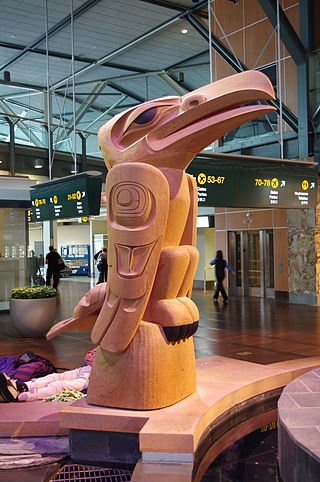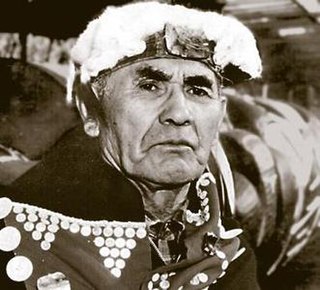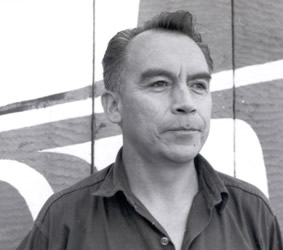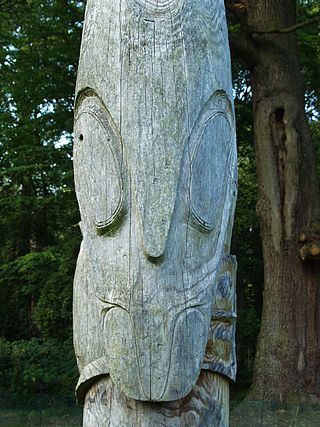Related Research Articles

Totem poles are monumental carvings found in western Canada and the northwestern United States. They are a type of Northwest Coast art, consisting of poles, posts or pillars, carved with symbols or figures. They are usually made from large trees, mostly western red cedar, by First Nations and Indigenous peoples of the Pacific Northwest Coast including northern Northwest Coast Haida, Tlingit, and Tsimshian communities in Southeast Alaska and British Columbia, Kwakwaka'wakw and Nuu-chah-nulth communities in southern British Columbia, and the Coast Salish communities in Washington and British Columbia.

The Kwakwa̱ka̱ʼwakw, also known as the Kwakiutl, are one of the indigenous peoples of the Pacific Northwest Coast. Their current population, according to a 2016 census, is 3,665. Most live in their traditional territory on northern Vancouver Island, nearby smaller islands including the Discovery Islands, and the adjacent British Columbia mainland. Some also live outside their homelands in urban areas such as Victoria and Vancouver. They are politically organized into 13 band governments.

Gitxsan are an Indigenous people in Canada whose home territory comprises most of the area known as the Skeena Country in English. Gitksan territory encompasses approximately 35,000 km2 (14,000 sq mi) of land, from the basin of the upper Skeena River from about Legate Creek to the Skeena's headwaters and its surrounding tributaries. Part of the Tsimshianic language group, their culture is considered to be part of the civilization of the Indigenous peoples of the Pacific Northwest Coast, although their territory lies in the Interior rather than on the Coast. They were at one time also known as the Interior Tsimshian, a term which also included the Nisga'a, the Gitxsan's neighbours to the north. Their neighbours to the west are the Tsimshian while to the east the Wetʼsuwetʼen, an Athapaskan people, with whom they have a long and deep relationship and shared political and cultural community.
Coast Mountain College (CMTN) is an accredited, publicly funded post-secondary educational institution that serves the communities of British Columbia's northwest region. CMTN offers field schools, college access, trades, university credit, health and human services programs. The college is a member of the University of the Arctic network, and Colleges and Institutes Canada (CiCan).

Dempsey Bob, is a Northwest Coast woodcarver and sculptor from British Columbia, Canada, who is of Tahltan and Tlingit First Nations descent. He was born in the Tahltan village of Telegraph Creek on the Stikine River in northwestern B.C., and is of the Wolf clan.
Freda Diesing was a Haida woman of the Sadsugohilanes Clan, one of very few female carvers of Northwest Coast totem poles and a member of the Council of the Haida Nation of British Columbia, Canada. Her Haida name is Skil Kew Wat, meaning "magical little woman."
Walter Harris, also known as Simogyet Geel, was a Canadian artist and hereditary chief from the Gitxsan (Gitksan) First Nation in northwestern British Columbia.

Northwest Coast art is the term commonly applied to a style of art created primarily by artists from Tlingit, Haida, Heiltsuk, Nuxalk, Tsimshian, Kwakwaka'wakw, Nuu-chah-nulth and other First Nations and Native American tribes of the Northwest Coast of North America, from pre-European-contact times up to the present.

Chief Mungo Martin or Nakapenkem, Datsa, was an important figure in Northwest Coast style art, specifically that of the Kwakwaka'wakw Aboriginal people who live in the area of British Columbia and Vancouver Island. He was a major contributor to Kwakwaka'wakw art, especially in the realm of wood sculpture and painting. He was also known as a singer and songwriter.

Henry Hunt was a First Nations woodcarver and artist from the Kwakwaka'wakw people of coastal British Columbia. He carved a number of totem poles which are on public display in Canada and internationally.

Norman Tait was a Nisga'a First Nations sculptor and totem pole carver from northwestern British Columbia, Canada.
Gerry Marks is a Canadian First Nations artist of Haida ancestry.
Ron Joseph Telek was a Canadian First Nations sculptor. He is a member of the Laxsgiik of the Nisga'a nation of northwestern British Columbia, and carries the hereditary name of Jagam Txalp meaning Four Canoes Coming into the Village. Telek's primary medium for his sculptures is wood, although he also includes other materials such as bone, moose hair and abalone into his work.
Chief William Jeffrey was a Canadian hereditary Tsimshian Chief, First Nations activist and carver. He attended residential school from 1914 to 1917. Though he desired to be a lawyer, his status as a First Nations person and government policy at the time prevented him from attending college for any profession other than the clergy.

Ellen Neel (1916–1966) was a Kwakwakaʼwakw artist woodcarver and is the first woman known to have professionally carved totem poles. She came from Alert Bay, British Columbia, and her work is in public collections throughout the world.

The Freda Diesing School of Northwest Coast Art focuses on traditional First Nations Pacific Northwest Coast Art and is located on the unceded territory of the Ts'msyen Nation in Terrace, BC; Canada.

The Salish peoples are indigenous peoples of the American and Canadian Pacific Northwest, identified by their use of the Salish languages which diversified out of Proto-Salish between 3,000 and 6,000 years ago.

Qaunaq Mikkigak was a Canadian artist and author. She was known primarily for sculpting but also created jewelry, story telling, drawing and performed throat singing. As an artist she was interested in arts and crafts and built works that were inspired by her imagination and emotions. She co-authored the children's books The Legend of the Fog and Grandmother Ptarmigan based on traditional Inuit stories. She was featured in the book Inuit Women Artists: Voices from Cape Dorset for her artwork and in Cape Dorset Sculpture. She died in 2020.

Stanley Clifford Hunt is a Canadian, First Nations Kwakiutl artist from British Columbia.
Tim Paul is a member of the Hesquiaht tribe from the Nuu-Chah-Nulth first nation. He is a master carver from Esperanza Inlet British Columbia. He was the senior carver at the Royal British Columbia Museum until 1992 when he left to oversee an indigenous education program for the Port Alberni school board on Vancouver Island.
References
- ↑ "Dale Campbell". Inuit Gallery of Vancouver Ltd. Retrieved 2024-05-05.
- 1 2 3 "Dale Campbell – Lattimer Gallery". www.lattimergallery.com. Retrieved 2023-05-11.
- ↑ "VIDEO and Story: Heart of Our City - Carving her best". The Northern View. 2017-05-10. Retrieved 2024-05-05.
- ↑ "Tahltan artist takes first place for paddle carving". The Northern View. 2017-09-12. Retrieved 2024-05-04.
- ↑ "VIDEO and Story: Heart of Our City - Carving her best". The Northern View. 2017-05-10. Retrieved 2024-05-05.